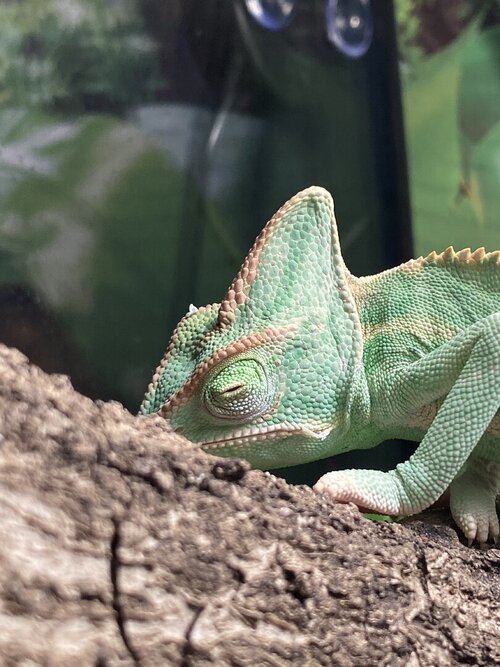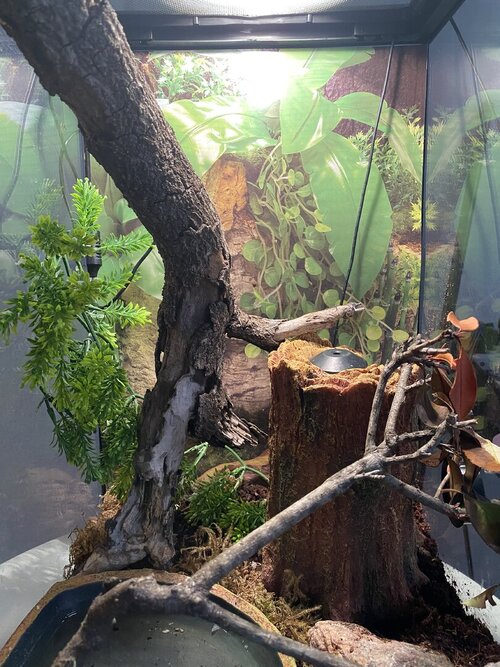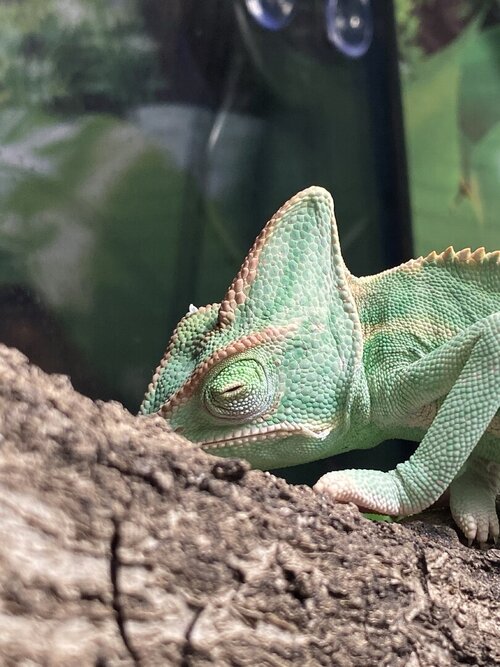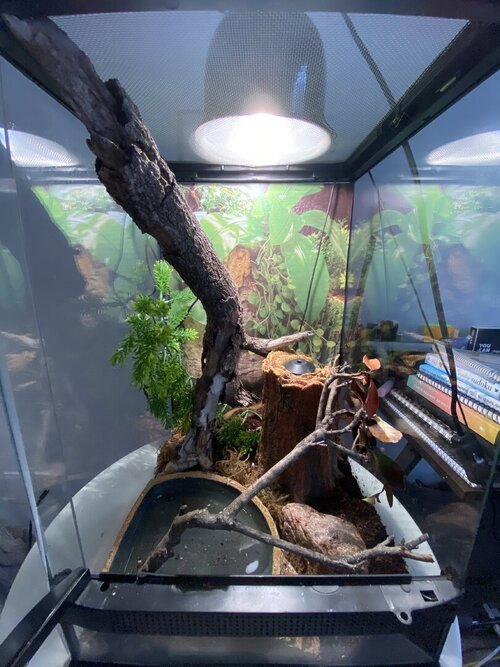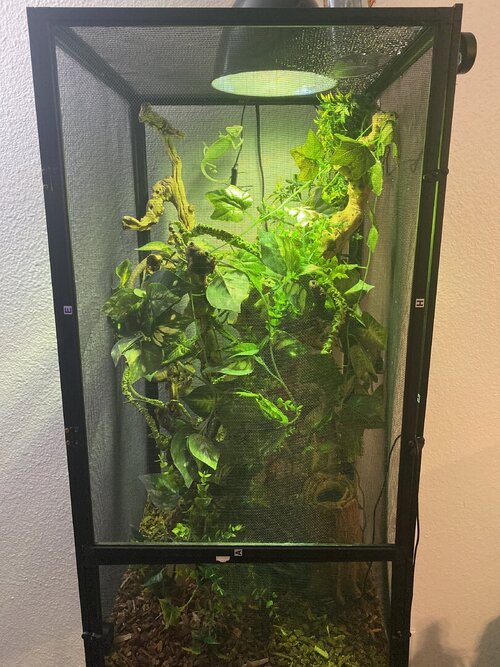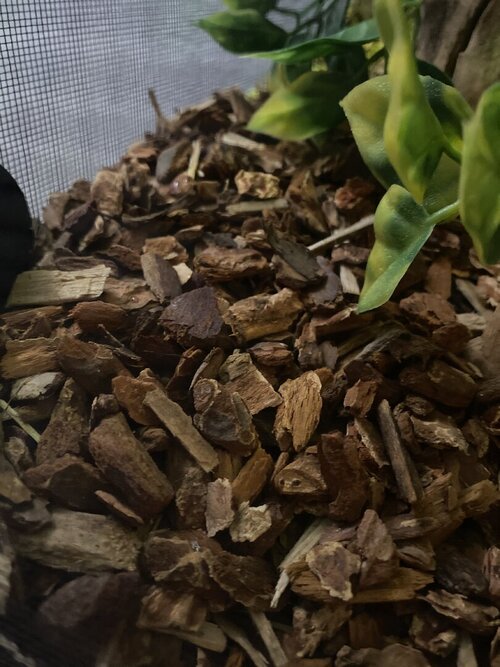PablotheChameleon_k&k
New Member
hi! My name is Karlee and my boyfriend and I bought our first ever male veiled chameleon about a week ago. We of course bought what we thought was great- a zoo med starter kit/cage. He started shedding a couple days ago but was struggling to get it off of his eyes. He was rubbing his left one on the branch we put in there and it was fine until we noticed his left eye was staying closed a little bit at a time (he would still open it and keep it open but every so often would close it for about a minute) and now after about 2 days he keeps it closed. I’ve noticed that there also might be a discoloration under his left eye. Im nervous because we aren’t sure what to do about it. Everything he does is the exact same though which is confusing! He acts normal and walks around his cage like it doesn’t bother him and doesn’t miss his prey ?What should we do?
Thank you so much for reading and we will gladly take any advice!!
- Your Chameleon - The species, sex, and age of your chameleon. How long has it been in your care? Male, veiled chameleon, he is we believe 6 months, we have had him for 1 week.
- Handling - How often do you handle your chameleon? At first we were handling him about once or twice 2 days after getting him. We didn’t overload him on the first day but after reading a lot of different websites and these forums we gave him more space and aren’t really handling him unless he shows he is interested in exploring outside of his cage. He hasn’t given any signs that he dislikes being handled or out of his cage but now especially with the eye issue we are trying to not handle him.
- Feeding - What are you feeding your cham? What amount? What is the schedule? How are you gut-loading your feeders? We have waxworms, superworms, dead crickets (they come in a can called Flukers) strawberries, bananas, grapes, romain lettuce, and collards. I try to give the waxworms and superworms a lot of the vegetation to try and gut-load but i would like any advice because it seems as though he loves the waxworms but wont really eat anything if its dead..? We were feeding him everyday and then we read that 6 month olds should be every other day so we just implemented that. We trued giving him the fruit and greens but he didn’t really seem interested as well as with the flukers crickets. Today im going back to get him crickets that are alive but i wasnt sure if i should get the smaller ones since he is still pretty small imo. We also feed him about 5 worms a day. Supplements - What brand and type of calcium and vitamin products are you dusting your feeders with and what is the schedule? So we have the zoo med repticalcium without d3 that we dust them in. We didn’t know that they needed more vitamins so I’m also picking up some of those as well but im really not sure what to get? We also put the zoo med reptisafe water droplets in all of his water suppliers.
- Watering - What kind of watering technique do you use? How often and how long to you mist? Do you see your chameleon drinking? We have a misting bottle that we use and we do it about 2-3 times a day- one in the morning and one once we get home but he also doesn’t seem to like it very much when we mist his cage and it gets in him so we dont really mist him directly. I’m not really sure how long we mist him for.. i would say about 20-30 seconds but we are scared to get too high of a humidity percentage. Ive seen him drink about twice but that was closer to when we first got him. We also do have a shallow watering bowl but after doing research we know that he doesn’t see it as drinking water but does sometimes walk through the water. I also plan on buying a dripper for him just because i do believe he’s dehydrated:/
- Fecal Description - Briefly note colors and consistency from recent droppings. Has this chameleon ever been tested for parasites? His poops seem normal i think? They are brown and soft yet firm, like it holds together but when we clean it out of his cage it seems to be like softer bouncier texture ? And we got him from petsmart so im not sure if they tested him but we haven’t gotten him tested.
- History - Any previous information about your cham that might be useful to others when trying to help you.
- Cage Type - Describe your cage (Glass, Screen, Combo?) What are the dimensions? Glass cage with the mesh top. I know that we got too small of a cage for him but we thought it was okay since he was smaller. I would say its a least 1’6” tall maybe and about 1’ wide and 1’ deep. We are trying to figure out which new one to get though? We are in Austin, Texas so we aren’t sure if glass or mesh is better for him?
- Lighting - What brand, model, and types of lighting are you using? What is your daily lighting schedule? We use the zoo med 60 watt day and night bulbs but after reading we are stopping using the red night bulb! We didn’t know they needed complete darkness because everywhere we were looking said they needed 12 hours of daylight and 12 hours of the red night bulb. When we wake up which is around 6:30 am we typically change from the red bulb to daylight bulb and now we will be implementing lights out at around 7-8 but we weren’t sure if we should use the red bulb for like an hour or two before bed so that way he would know its bed time and gets him ready for it? Or if we are leaving his day light on too much?
- Temperature - What temp range have you created (cage floor to basking spot)? Lowest overnight temp? How do you measure these temps? The cage floor typically ranges between 75-82F and the top is normally around 83-88F. Again with keeping the red light on the temperature has stayed in those numbers so we don’t know how low it drops at night with no light. We have a sticky thermometer in the bottom of his cage and we have another thermometer/ hygrometer in one closer to his basking spots.
- Humidity - What are your humidity levels? How are you creating and maintaining these levels? What do you use to measure humidity? The humidity ranges from 38%-85%. We have a fogger that we kept on almost all day because we read that it wasn’t good to have a low percentage but we now know thats not the case and we turn it off after misting sessions and only turn it on when the humidity seems to be getting a little low but it has never dropped below 38%.
- Plants - Are you using live plants? If so, what kind? We have branches that we found outside- some with leaves on them but we weren’t sure if we should take the leaves off? Its from a bush near our apartment building. He doesn’t eat the leaves or is actually rarely near them unless hes moving around. We do know however that we are lacking in husbandry which is why im going out today to buy some plants as well!
- Placement - Where is your cage located? Is it near any fans, air vents, or high traffic areas? At what height is the top of the cage relative to your room floor? We had him out in the living room on a side table about 4 feet off the ground. Again we do know its not nearly big/high enough which is why we are looking for a new one! But since his eye issue we moved him into our bedroom where there is more privacy but there isn’t a lot of air flow which im still unsure about as well? Like we don’t know if he supposed to have quite a bit of air flow- we do have a vent in our bedroom but its not constantly going.
- Location - Where are you geographically located? Austin, Texas
Thank you so much for reading and we will gladly take any advice!!
Attachments
Last edited:

